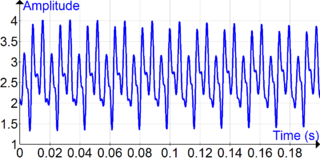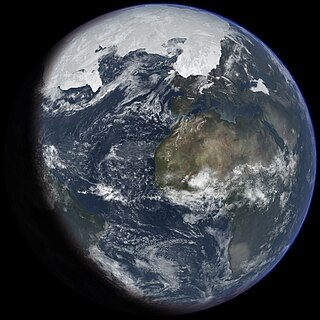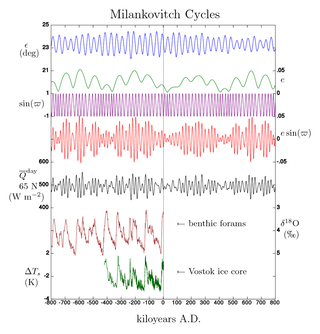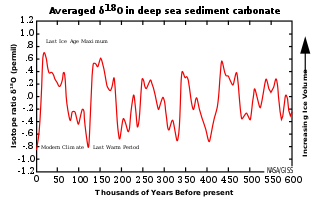Contents
Period may refer to:
Period may refer to:
A day is the time period of a full rotation of the Earth with respect to the Sun. On average, this is 24 hours. As a day passes at a given location it experiences morning, noon, afternoon, evening, and night. This daily cycle drives circadian rhythms in many organisms, which are vital to many life processes.

In mathematics, Fourier analysis is the study of the way general functions may be represented or approximated by sums of simpler trigonometric functions. Fourier analysis grew from the study of Fourier series, and is named after Joseph Fourier, who showed that representing a function as a sum of trigonometric functions greatly simplifies the study of heat transfer.

An ice age is a long period of reduction in the temperature of Earth's surface and atmosphere, resulting in the presence or expansion of continental and polar ice sheets and alpine glaciers. Earth's climate alternates between ice ages and greenhouse periods, during which there are no glaciers on the planet. Earth is in the Quaternary glaciation. Individual pulses of cold climate within an ice age are termed glacial periods, and intermittent warm periods within an ice age are called interglacials or interstadials.

A year is the orbital period of a planetary body, for example, the Earth, moving in its orbit around the Sun. Due to the Earth's axial tilt, the course of a year sees the passing of the seasons, marked by change in weather, the hours of daylight, and, consequently, vegetation and soil fertility. In temperate and subpolar regions around the planet, four seasons are generally recognized: spring, summer, autumn and winter. In tropical and subtropical regions, several geographical sectors do not present defined seasons; but in the seasonal tropics, the annual wet and dry seasons are recognized and tracked.

In astronomy, a light curve is a graph of the light intensity of a celestial object or region as a function of time, typically with the magnitude of light received on the y-axis and with time on the x-axis. The light is usually in a particular frequency interval or band.

A period on the periodic table is a row of chemical elements. All elements in a row have the same number of electron shells. Each next element in a period has one more proton and is less metallic than its predecessor. Arranged this way, elements in the same group (column) have similar chemical and physical properties, reflecting the periodic law. For example, the halogens lie in the second-to-last group and share similar properties, such as high reactivity and the tendency to gain one electron to arrive at a noble-gas electronic configuration. As of 2022, a total of 118 elements have been discovered and confirmed.

The orbital period is the amount of time a given astronomical object takes to complete one orbit around another object. In astronomy, it usually applies to planets or asteroids orbiting the Sun, moons orbiting planets, exoplanets orbiting other stars, or binary stars. It may also refer to the time it takes a satellite orbiting a planet or moon to complete one orbit.
Term may refer to:

Milankovitch cycles describe the collective effects of changes in the Earth's movements on its climate over thousands of years. The term was coined and named after Serbian geophysicist and astronomer Milutin Milanković. In the 1920s, he hypothesized that variations in eccentricity, axial tilt, and precession combined to result in cyclical variations in the intra-annual and latitudinal distribution of solar radiation at the Earth's surface, and that this orbital forcing strongly influenced the Earth's climatic patterns.
Cycle, cycles, or cyclic may refer to:

The tritos is an eclipse cycle of 3,986.628 days . It corresponds to:
Periodicity or periodic may refer to:
Orbital forcing is the effect on climate of slow changes in the tilt of the Earth's axis and shape of the Earth's orbit around the Sun. These orbital changes modify the total amount of sunlight reaching the Earth by up to 25% at mid-latitudes. In this context, the term "forcing" signifies a physical process that affects the Earth's climate.

The Quaternary glaciation, also known as the Pleistocene glaciation, is an alternating series of glacial and interglacial periods during the Quaternary period that began 2.58 Ma and is ongoing. Although geologists describe this entire period up to the present as an "ice age", in popular culture this term usually refers to the most recent glacial period, or to the Pleistocene epoch in general. Since Earth still has polar ice sheets, geologists consider the Quaternary glaciation to be ongoing, though currently in an interglacial period.
In mathematics, in the study of iterated functions and dynamical systems, a periodic point of a function is a point which the system returns to after a certain number of function iterations or a certain amount of time.
The secular variation of a time series is its long-term, non-periodic variation. Whether a variation is perceived as secular or not depends on the available timescale: a variation that is secular over a timescale of centuries may be a segment of what is, over a timescale of millions of years, a periodic variation. Natural quantities often have both periodic and secular variations. Secular variation is sometimes called secular trend or secular drift when the emphasis is on a linear long-term trend.

The 100,000-year problem of the Milankovitch theory of orbital forcing refers to a discrepancy between the reconstructed geologic temperature record and the reconstructed amount of incoming solar radiation, or insolation over the past 800,000 years. Due to variations in the Earth's orbit, the amount of insolation varies with periods of around 21,000, 40,000, 100,000, and 400,000 years. Variations in the amount of incident solar energy drive changes in the climate of the Earth, and are recognised as a key factor in the timing of initiation and termination of glaciations.
A tropical year or solar year is the time that the Sun takes to return to the same position in the sky of a celestial body of the Solar System such as the Earth, completing a full cycle of seasons; for example, the time from vernal equinox to vernal equinox, or from summer solstice to summer solstice. It is the type of year used by tropical solar calendars. The solar year is one type of astronomical year and particular orbital period. Another type is the sidereal year, which is the time it takes Earth to complete one full orbit around the Sun as measured with respect to the fixed stars, resulting in a duration of 20 minutes longer than the tropical year, because of the precession of the equinoxes.
This glossary of astronomy is a list of definitions of terms and concepts relevant to astronomy and cosmology, their sub-disciplines, and related fields. Astronomy is concerned with the study of celestial objects and phenomena that originate outside the atmosphere of Earth. The field of astronomy features an extensive vocabulary and a significant amount of jargon.